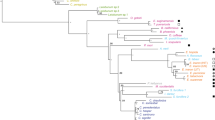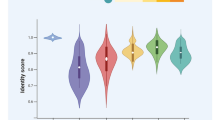Abstract
The nuclear 16S-like rRNA coding regions of two strains of the kinetoplastid flagellateDimastigella trypaniformis Sandon (strain Ulm and strain Glasgow) were sequenced and phylogenetically analyzed. Strain Ulm was isolated from the hindgut contents of the Australian termiteMastotermes darwiniensis Frogatt, whereas strain Glasgow originates from a soil sample in Scotland. After preparation of genomic DNA the 16S-like rRNA coding regions were amplified using polymerase chain reaction (PCR) technology. The amplification products were cloned in a plasmid vector and sequenced according to standard methods. The sequence of the 16S-like rRNA coding region of strain Ulm differs less than 2% from the sequence of strain glasgow, indicating that the two strains are most probably members of one species. Phylogenetic analysis of the sequence data positionedD. trypaniformis Sandon as a deep branching lineage near the root of the kinetoplastid group of flagellates.
Similar content being viewed by others
References
Berbee ML, Taylor JW (1992) Detecting morphological convergence in true fungi, using 18S rRNA gene sequence data. Biosystems 28:117–125
Birnboim HC, Doly J (1979) A rapid alkaline extraction procedure for sequencing recombinant plasmid DNA. Nucleic Acids Res 7:1513–1522
Breunig A, Brugerolle G, Vickerman K, Hertel H, König H (1993) Isolation and ultrastructural features of a new strain ofDimastigella trypaniformis Sandon 1928 (Bodonina, Kinetoplastida) and comparison with a previously isolated strain. Eur J Protistol 29:416–424
Briones MRS, Nelson K, Beverley SM, Affonso HT, Camargo EP, Floeter-Winter LM (1992)Leishmania tarentolae taxonomic relatedness inferred from phylogenetic analysis of the small subunit ribosomal RNA gene. Mol Biol Parasitol 53:121–128
Campbell DA (1992)Bodo caudatus medRNA and 5S rRNA genes: tandem arrangement and phylogenetic analyses. Biochem Biophys Res Commun 182:1053–1058
Felsenstein J (1985) Confidence limits on phylogenies: an approach using the bootstrap. Evolution 39:783–791
Felsenstein J (1990) PHYLIP 3.3. Department of Genetics, University of Washington, Seattle
Fernandes P, Nelson K, Beverley SM (1993) Evolution of nuclear ribosomal RNAs in kinetoplastid protozoa: perspectives on the age and origins of parasitism. Proc Natl Acad Sci USA 90:11608–11612
Hendriks L, Broeckhoven C van, Vandenberghe A, Peer Y van de, De Wachter R (1988) Primary and secondary structure of the 18S ribosomal RNA of the bird spiderEurypelma californica and evolutionary relationships among eukaryotic phyla. Eur J Biochem 177:15–20
Hernandez R, Rios P, Valdes AM, Pinero D (1990) Primary structure ofTrypanosoma cruzi small-subunit ribosomal RNA coding region: comparison with other trypanosomatids. Mol Biol Parasitol 41:207–212
Jukes TH, Cantor CR (1969) Evolution of protein molecules. In: Munro HN (ed) Mammalian protein metabolism. vol 3. Academic Press, New York, pp 21–123
Kimura M (1980) A simple method for estimating evolutionary rate of base substitutions through comparative studies of nucleotide sequences. J Mol Evol 16:111–120
Lake JA, De la Cruz VF, Ferreira PCG, Morel C, Simpson L (1988) Evolution of parasitism: kinetoplastid protozoan history reconstructed from mitochondrial rRNA gene sequences. Proc Natl Acad Sci USA 85:4779–4783
Lecointre G, Philippe H, Le V, Le Guyader H (1994) Species sampling has a major impact on phylogenetic inference. Mol Phylogen Evol (in press)
Manwell RD (1955) Some evolutionary possibilities in the history of the malaria parasites. Indian J Malariol 9:247–253
Marmur J (1961) A procedure for the isolation of deoxyribonucleic acid from micro-organisms. J Mol Biol 3:208–218
Medlin L, Elwood HJ, Stickel S, Sogin ML (1988) The characterization of enzymatically amplified eukaryotic 16S-like rRNA-coding regions. Gene 71:491–499
Munson DA, Nerad TA (1993) A new species ofDimastigella from Lake Malawi, Africa. J Euk Microbiol 40:6A
Nanney DL, Meyer EB, Simon EM, Preparata RM (1989) Comparison of ribosomal and isozymic phylogenies of tetrahymenine ciliates. J Protozool 36:1–8
Neefs JM, Peer Y van de, Hendriks L, De Wachter R (1990) Compilation of small ribosomal subunit RNA sequences. Nucleic Acids Res 18:2237–2317
Neefs JM, Peer Y van de, De Rijk P, Chapelle S, De Wachter R (1993) Compilation of small ribosomal subunit RNA structures. Nucleic Acids Res 21:3025–3049
Opperdoes, FR (1985) Biochemical peculiarities of trypanosomes, African and South American. Br Med Bull 41:130–136
Philippe H (1994) MUST: a computer package of management utilities for sequences and trees. Nucleic Acids Res (in press)
Poljansky GI (1992) Protozoology and the problem of species. J protozool 39:177–180
Saiki R, Gelfand DH, Stoffel S, Schaft SJ, Higuchi R, Horn GT, Mullis KB, Ehrlich HA (1988) Primer-directed enzymatic amplification of DNA with a thermostable DNA polymerase. Science 239:487–491
Saitou N, Nei M (1987) The neighbor-joining method: a new method for reconstructing phylogenetic trees. Mol Biol Evol 4:406–425
Sambrook J, Fritsch EF, Maniatis T (1989) Molecular cloning. A laboratory manual. Cold Spring Harbor Laboratory Press, Cold Spring Harbor
Sanger F, Nicklen S, Coulson AR (1977) DNA sequencing with chain-terminating inhibitors. Proc Natl Acad Sci USA 74:5463–5467
Schnare MN, Collings JC Gray MW (1986) Structure and evolution of the small subunit ribosomal RNA gene ofCrithidia fasciculata. Curr Genet 10:405–410
Sogin ML (1991) Early evolution and the origin of eukaryotes. Curr Opin Gen Dev 1:457–463
Sogin ML, Elwood HJ, Gunderson JH (1986) Evolutionary diversity of eukaryotic small-subunit rRNA genes. Proc Natl Acad Sci USA 83:1383–1387
Swofford DL (1985) PAUP: Phylogenetic analysis using parsimony, version 2.4.1. Illinois Natural History Survey, Champaign
Swofford DL, Olsen GJ (1990) Phylogeny reconstruction. In Hillis DM, Moritz C (eds) Molecular systematics. Sinauer Associates, Sunderland, pp 411–501
Tibayrenc M, Neubauer K, Barnabe C, Guerrini F, Skarecky D, Ayala FJ (1993) Genetic characterization of six parasitic protozoa: parity between random-primer DNA typing and multilocus enzyme electrophoresis. Proc Natl Acad Sci USA 90:1335–1339
Vickerman K (1989) Phylum Zoomastigina, class Kinetoplastida. In: Margulis L, Corliss JO, Melkonian M, Chapman DJ (eds) Handbook of Protista Jones and Bartlett, Boston, pp 215–238
Vickerman K (1991) Organization of the bodonid flagellates. In: Patterson DJ, Larsen J (eds) The Biology of free-living heterotrophic flagellates. vol 45. Clarendon, Oxford, pp 159–176
Woese CR (1987) Bacterial evolution. Microbiol Rev 51:221–271
Author information
Authors and Affiliations
Rights and permissions
About this article
Cite this article
Berchtold, M., Philippe, H., Breunig, A. et al. The phylogenetic position ofDimastigella trypaniformis within the parasitic kinetoplastids. Parasitol Res 80, 672–679 (1994). https://doi.org/10.1007/BF00932951
Received:
Accepted:
Issue Date:
DOI: https://doi.org/10.1007/BF00932951




